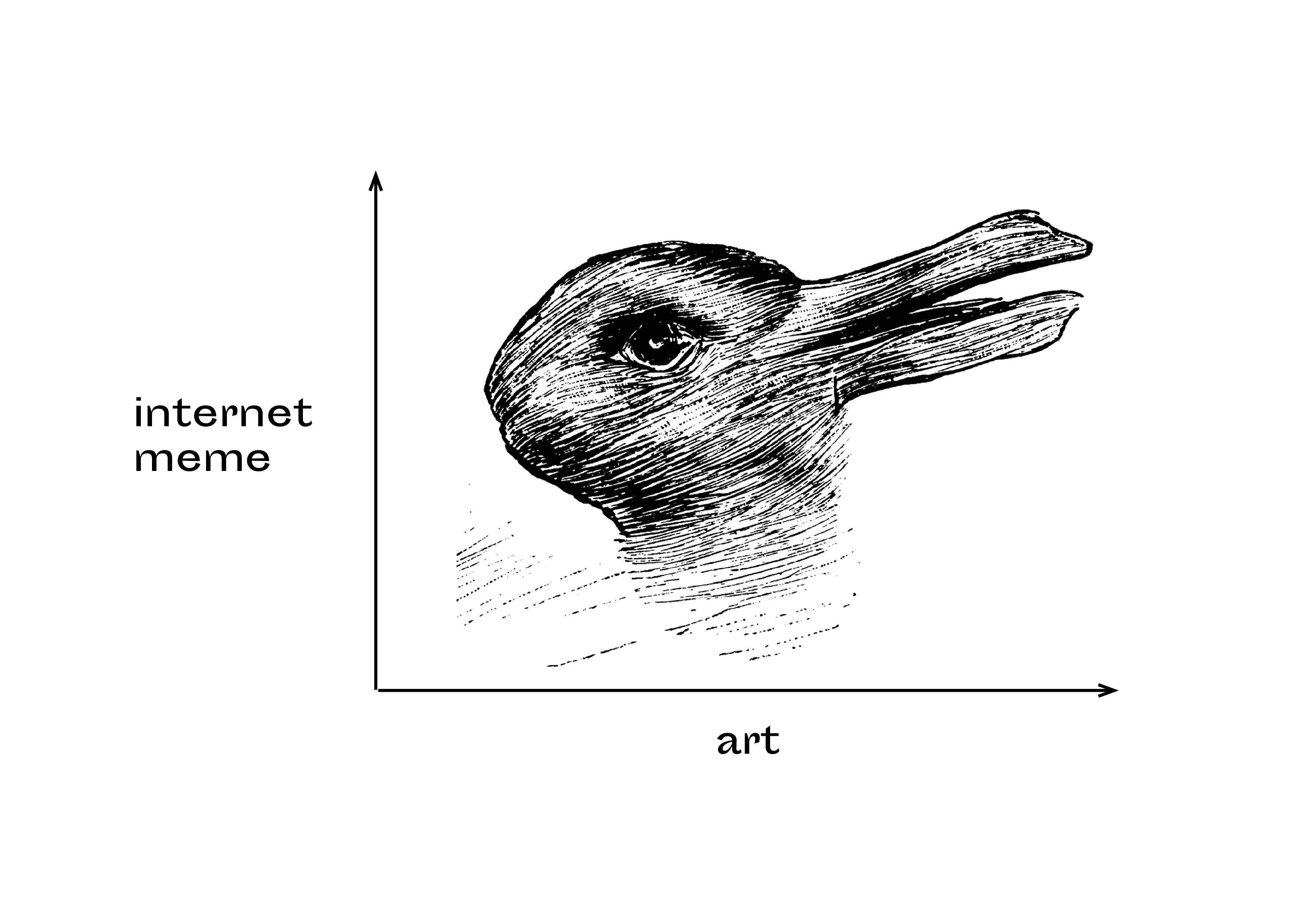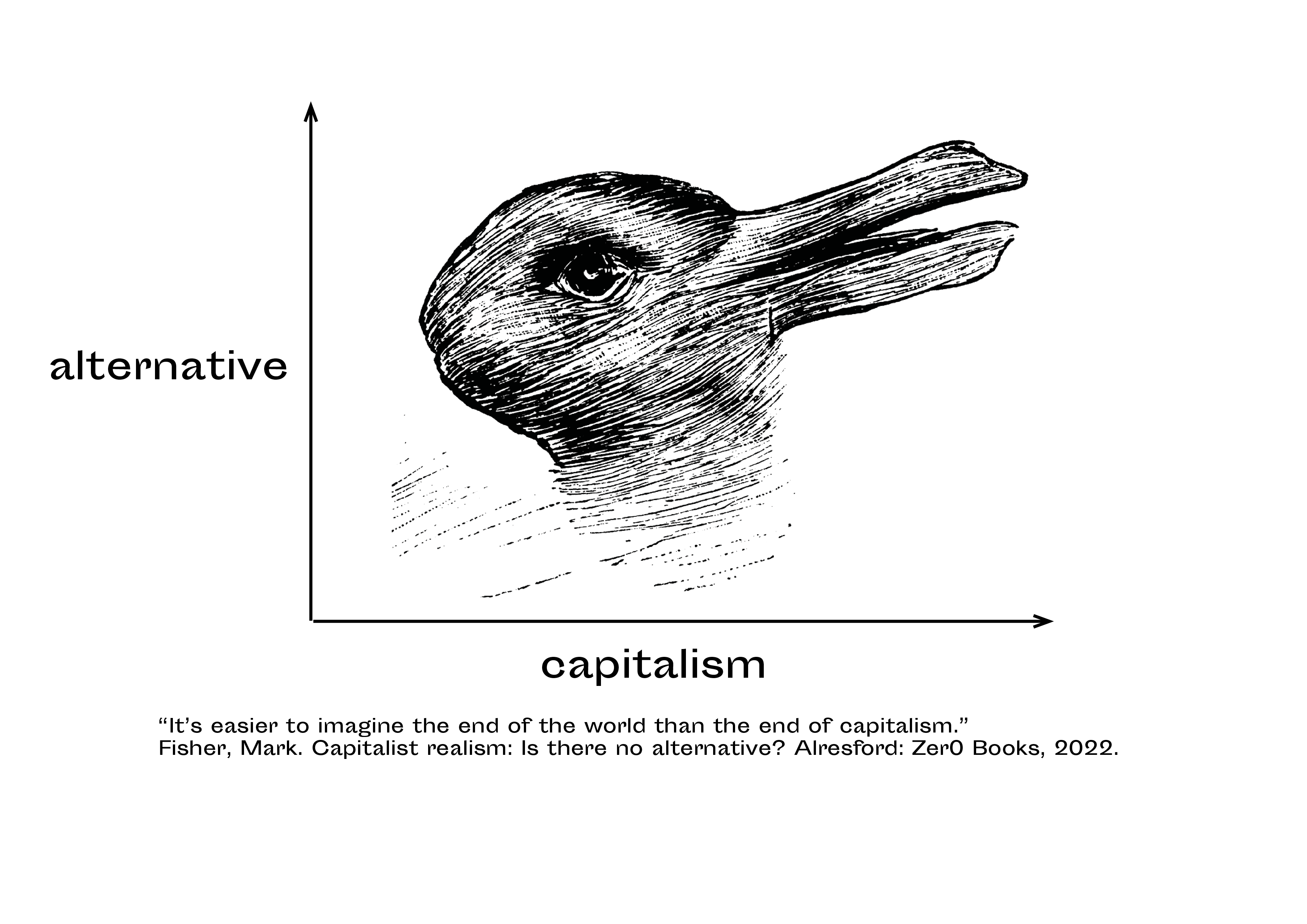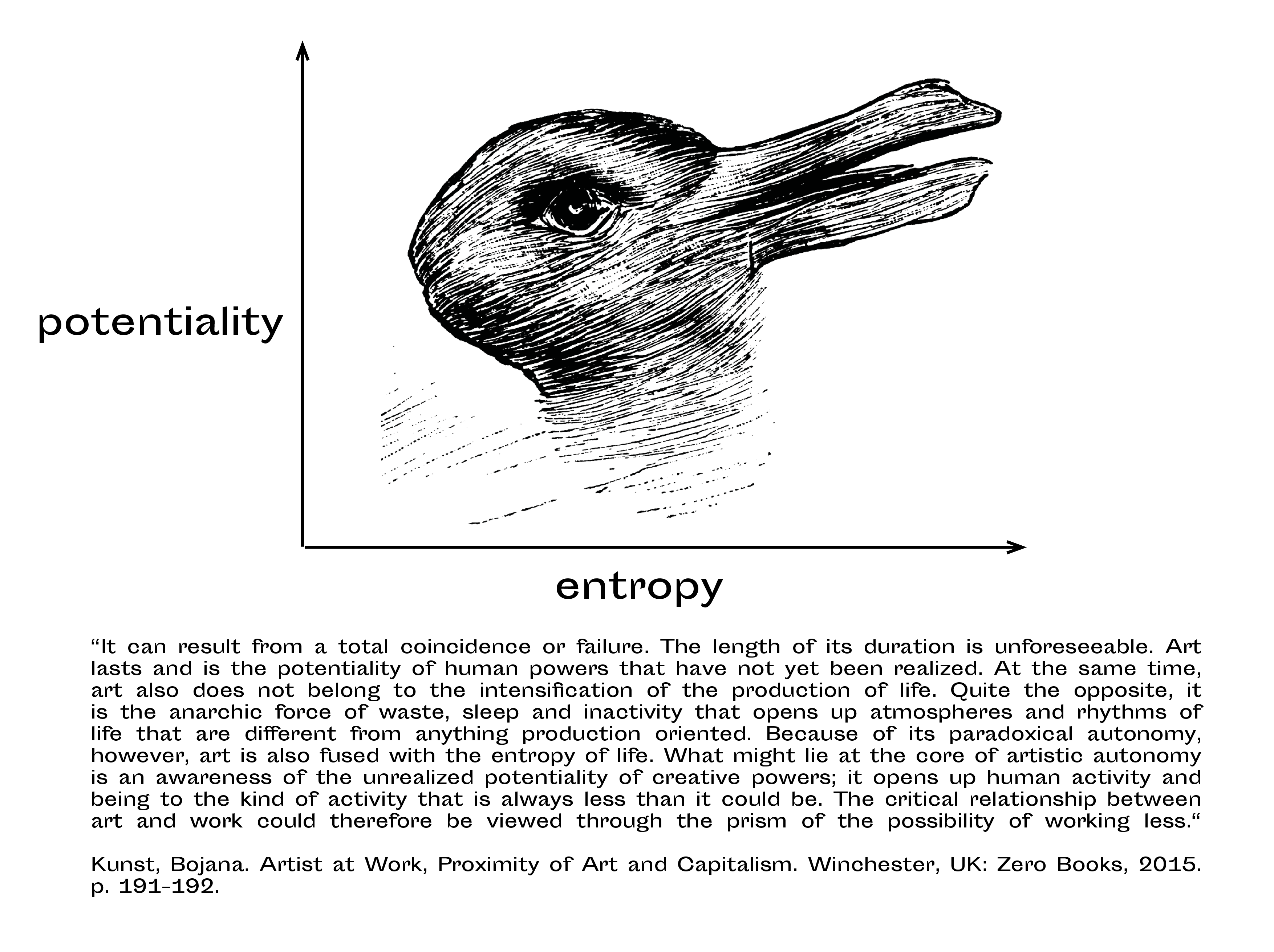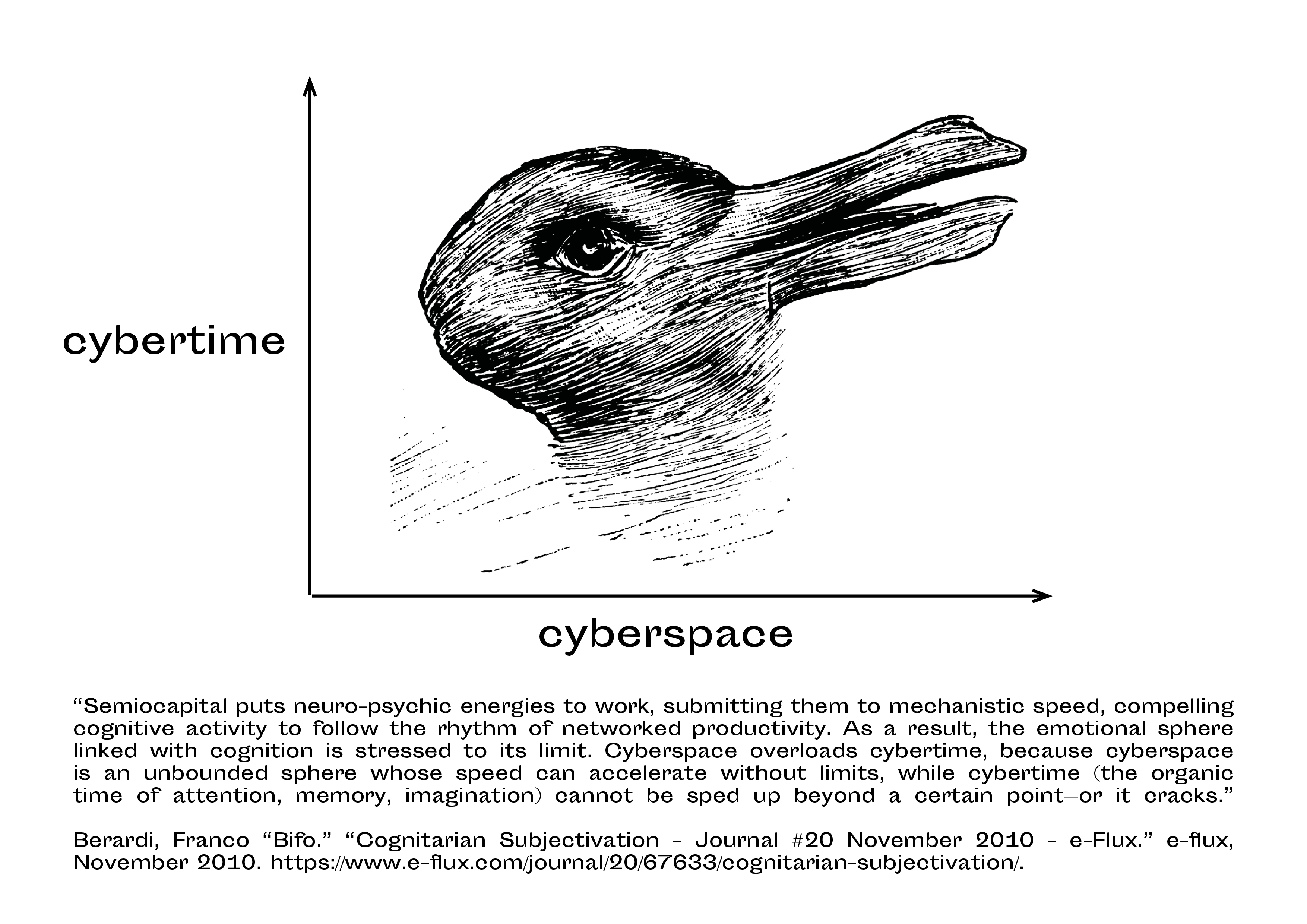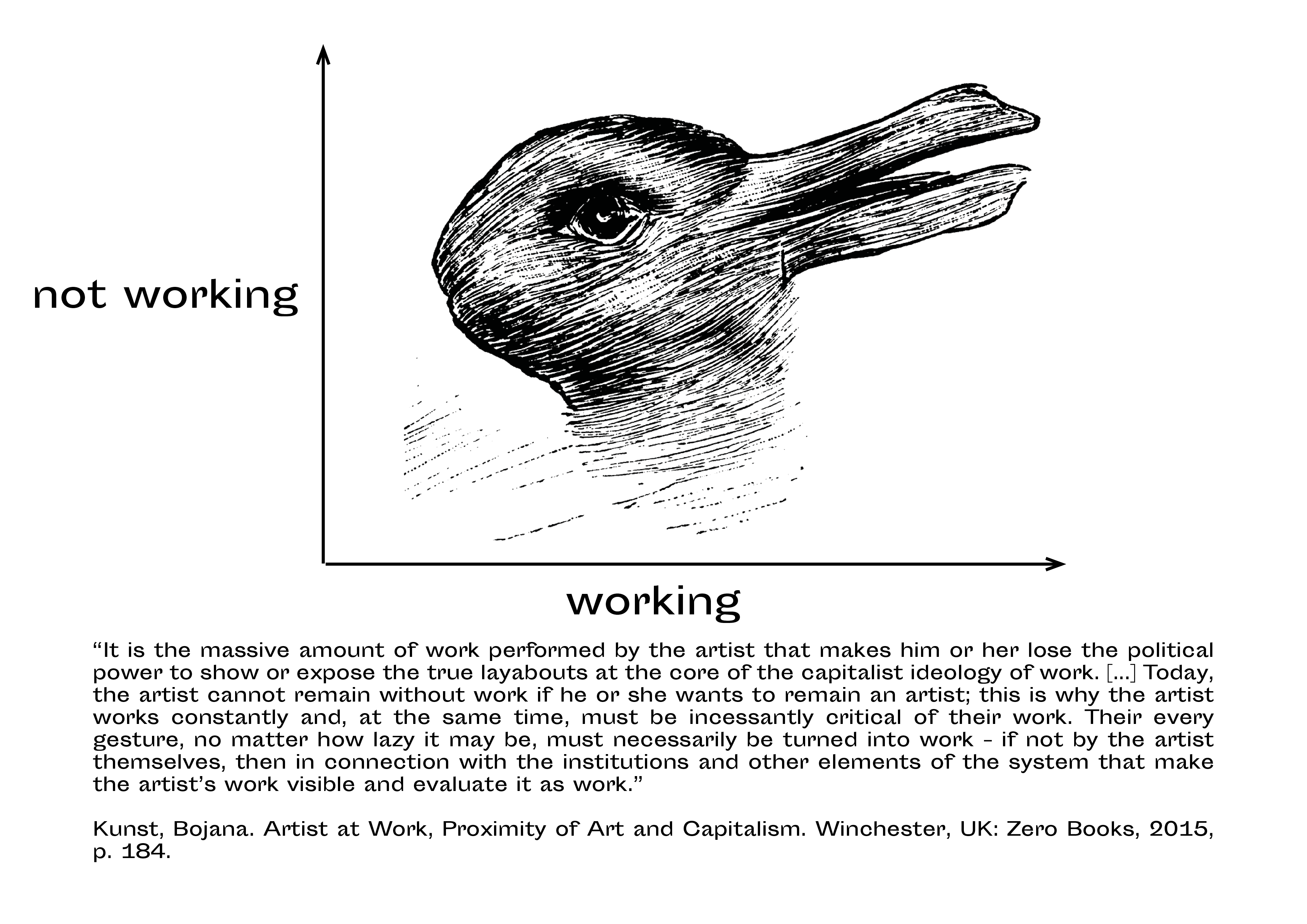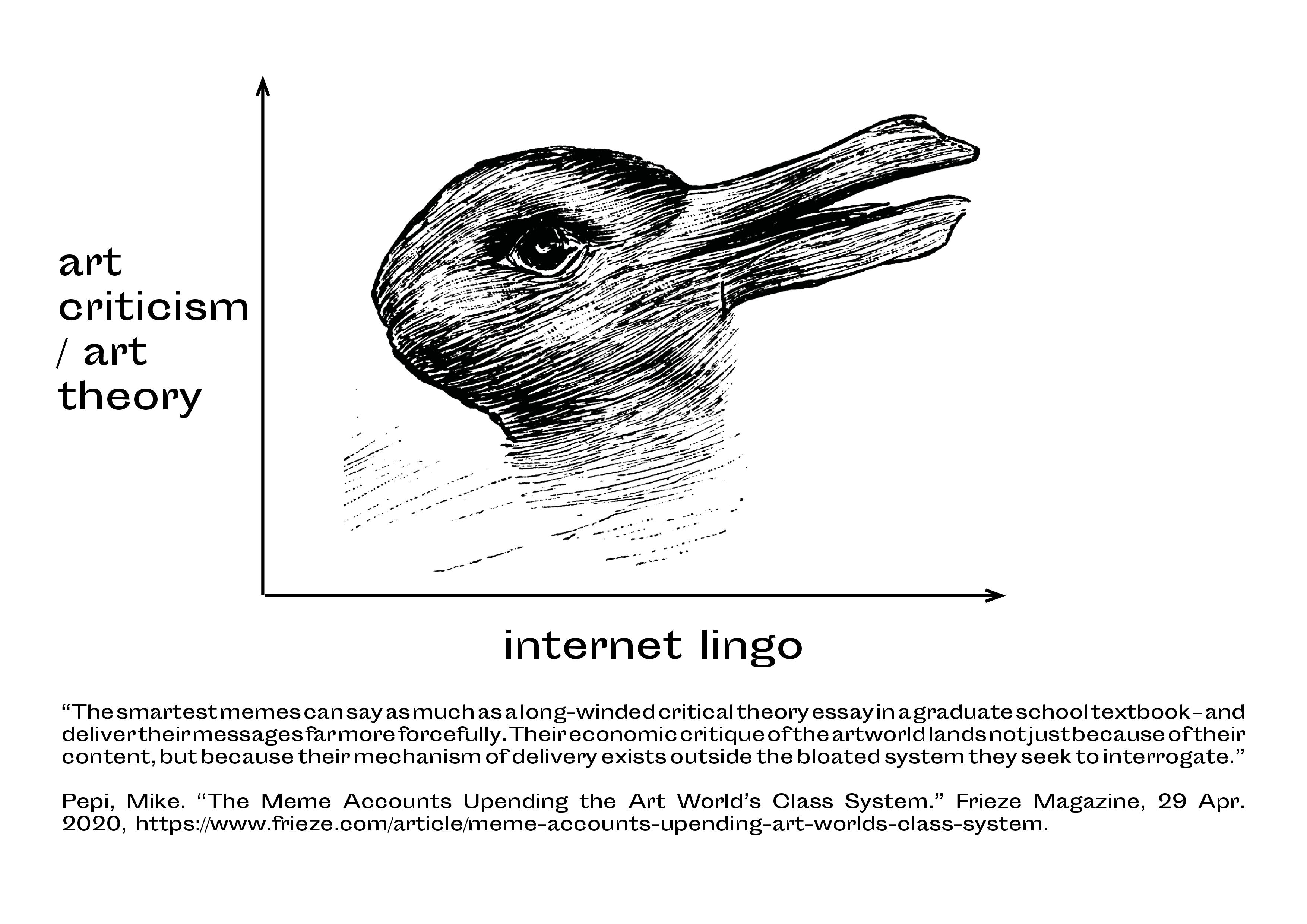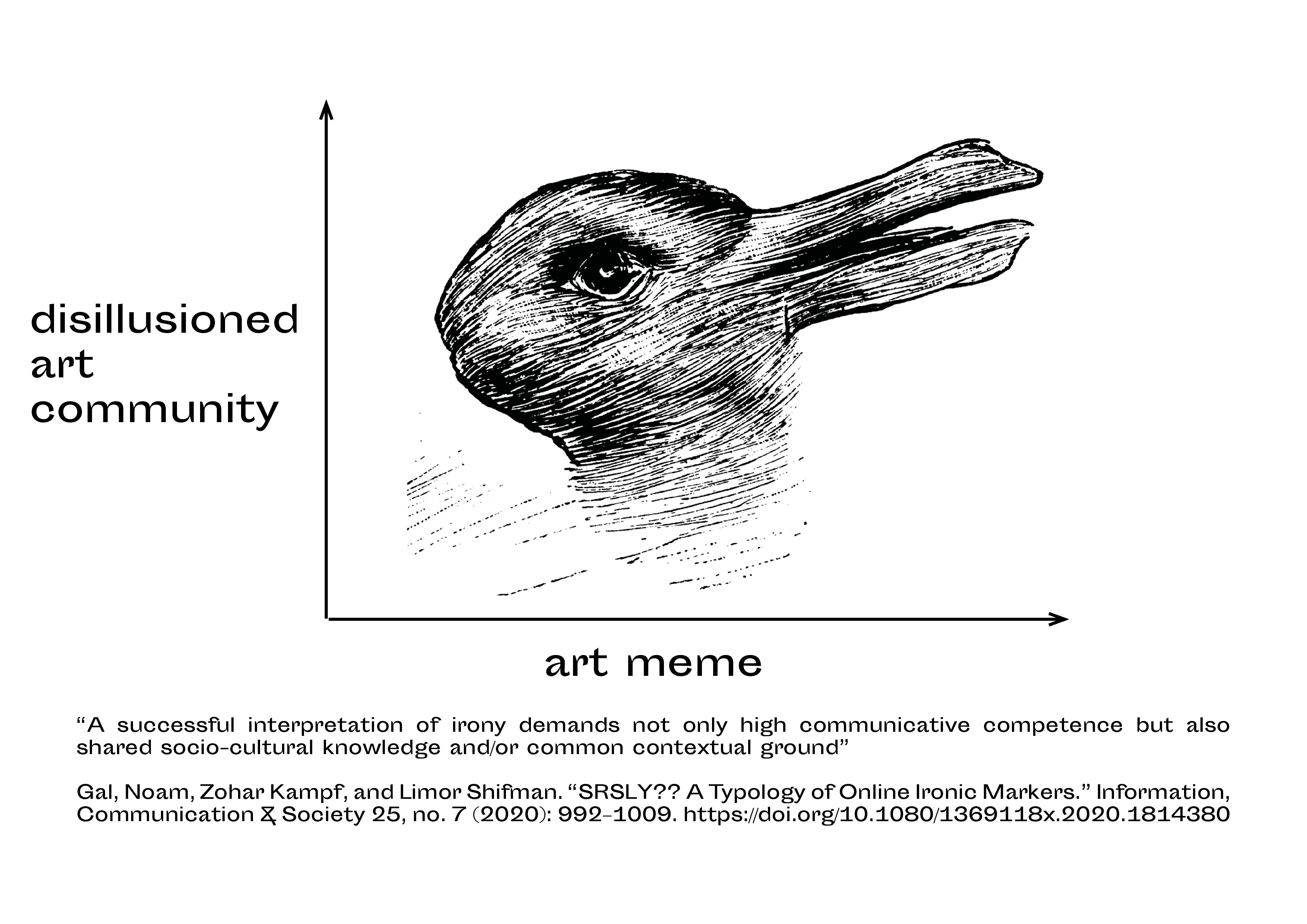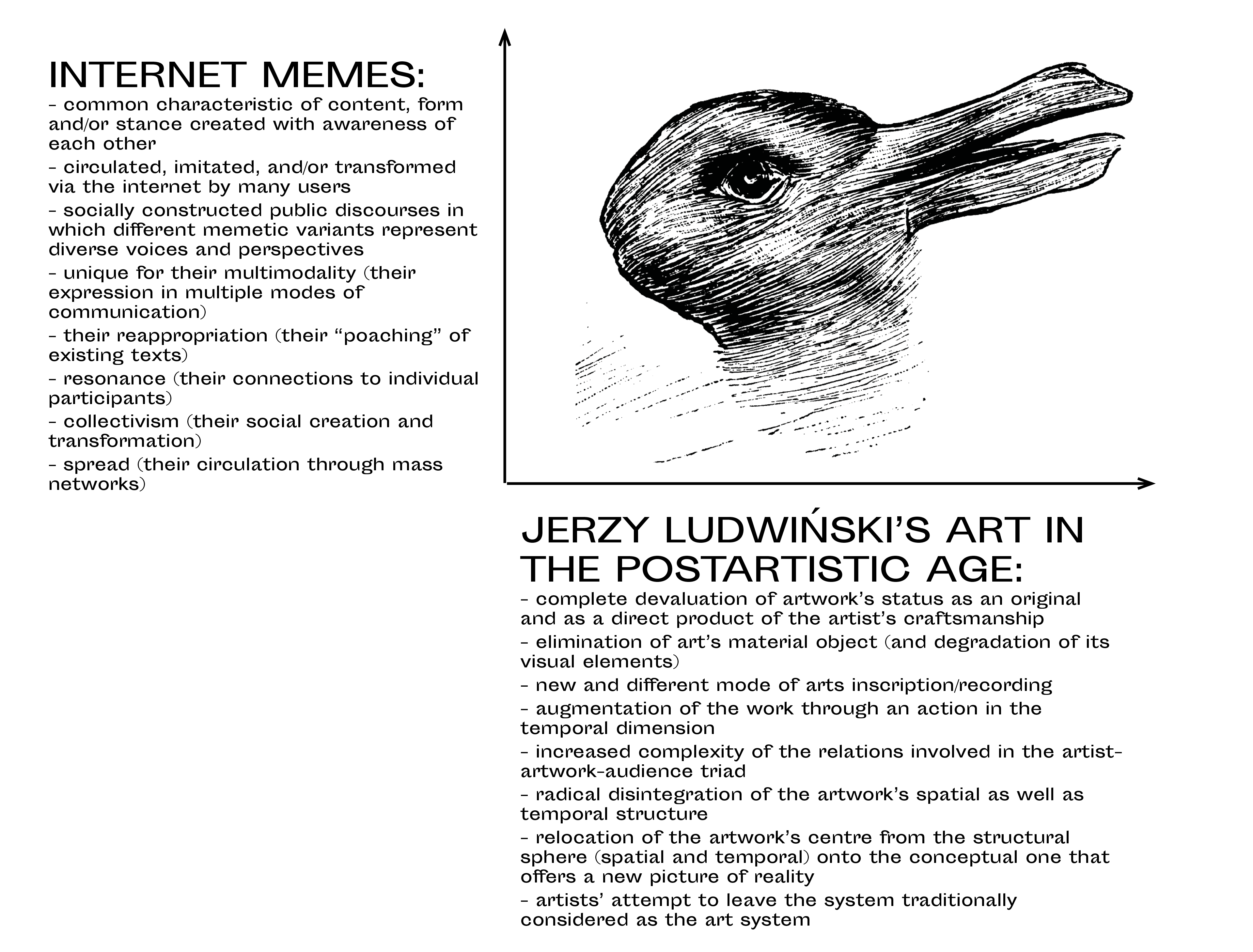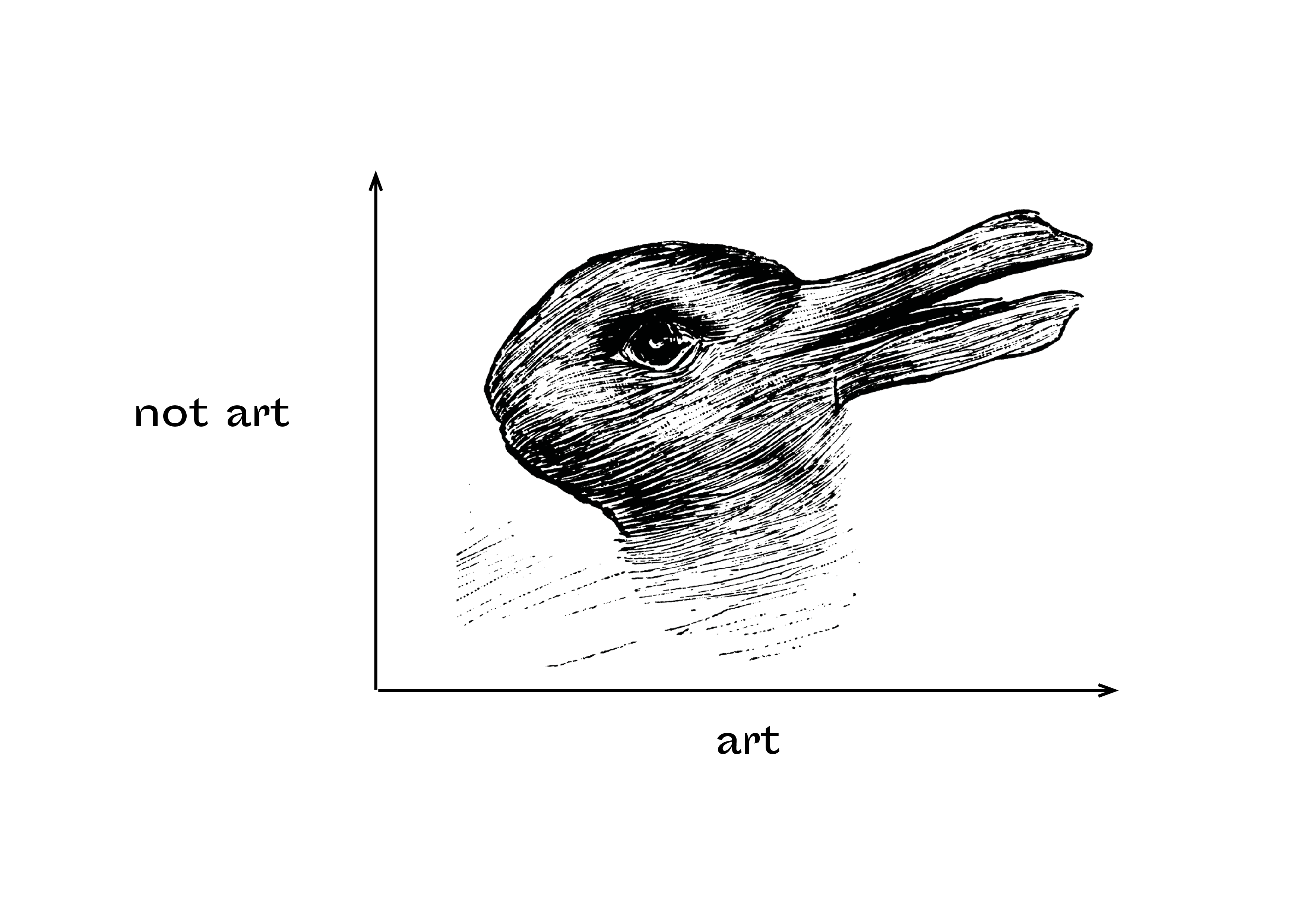“Work, work, work, work, work,
You see me I be work,
Work, work, work, work,
You see me do me
Dirt, dirt, dirt, dirt, dirt,
There’s something ‘bout that work,
work, work, work, work”
Rihanna, Work, song lyrics, 26.01.2016
The Myth Pervades
“Here I come to my keyword for this year: resignation” – states Franco “Bifo” Berardi, which leaves me with a belief that I’m not the only one that has become interested in the politics of withdrawal. Recent events, especially the Covid-19 pandemic forced changes in our lives, often leading us to a suspension of our otherwise pursued careers (including artistic ones) or to just not be present. Berardi proposes that in order to overcome the current depression we should delve deeper into it. Resign and abandon our expectations. What does this mean for an artist if we take this position as a starting point in political terms? What if an artist gives up and refuses to work? What Marcel Duchamp and his mythologized refusal remind us is "in fact, it really isn't easy to be truly lazy and do nothing."1Marcadé Bernard. (2006). Laisser Pisser Le Mérinos: La Paresse de Marcel Duchamp. Échoppe, op. cit. 48. [in:] Lazzarato, M. (2014). Marcel Duchamp and the refusal of Work. Semiotext(e), p. 11.
Art has long been seen as a form of escape itself – a form of privileged escapism. Some are trying to escape into art, while others are escaping from it. For those considering leaving the art world, there may be a few possible ways worth considering, and it's also important to reflect on the meaning behind such artistic withdrawals. The dialectic that governs them is one in which artists are co-opted by the field from which they sought to distance themselves, it is difficult to imagine an alternative, a new mode of non-compliance and rejection of the regime of capital.
I am probing the ideas of Jerzy Ludwiński’s postartistic age as an ultimate and utopian understanding of a merger between art and life using examples of different artistic “non-movements” or “inactions”, here narrowed down to the memetic practice of @freeze_magazine art meme page. What is the logic of the meme, and can it be used to develop progressive ideas? My interests stem from the role of the attention economy and the tentacles of immaterial labour understood as unwittingly performed cognitive-emotional labor under the ubiquitous pressure of hyper-productivity and effectiveness. The role of memes and their features like the use of humour is undeniably an important part of the power dynamics of the attention economy. The innocuous escapist pleasure we find in the internet vernacular may in fact be part of increasing the efficacy of big data algorithms. The same question is haunting me as the one posed by Berardi “Is it still possible to forge social autonomy from capitalist dominance in the psycho-economic framework of semiocapitalism?” The motivations behind starting the art meme page @freeze_magazine and abandoning the regular artistic practice were, besides disappointments, to exit the art world and art market, connected with the artistic strategy to escape towards non-capitalist and non-neoliberal ethos.
While being an artist makes us presume that you work as an artist, in fact, the entanglement of art and work is full of paradoxes. The relationship between the terms "art" and "work" poses a linguistic challenge, as the words carry distinct meanings and connotations that are unique to the English language. It is necessary to recognize and consider these language-specific meanings and implications when examining the relationship between art and work. Both words are much more universal than, for example, their translations in my native language. In English, your diploma states you are a “Master of Art”, even though you did not study art.
You are an ‘escape artist’ even if you are no ‘artist’, but instead a virus or a fungus – as demonstrated by the search results I obtained from the University of Amsterdam Library’s catalogue, which showed a majority of non-art related articles for the phrase: escape artist. There is the ‘art of living’, ‘state of art’, ‘latte art’, ‘fine art’, ‘low art’, ‘work of art’, ‘artwork’, ‘art world’ and so on. Producing this multitude of ‘arts’ requires labour and work, even if art does not exclusively belong to the realm of material objects, needless to say, there’s always work to be done – hard work, important work, fieldwork, research work, art work, artwork, not to mention the art research or artistic research in this processes of blurring the lines between the functions and relations of work and art. Those various connotations and connections give us a possible broad spectrum of critical semiotic analysis, while also remaining open to serendipitous and coincidental discoveries. Hence is art without work possible? In both senses – of work created by artists and work performed by them?
Paradoxes of an Artist-Not-At-Work
Absence, emptiness and nothingness as an aesthetic have a long tradition in Western art, often manifested as an empty, white space – a void. Its traditions go back to the 19th century, dada, conceptualism, land art and many other practices that could be better described with terms developed by Steven Wright, as on the margins, the boundaries of what is and what isn’t art are ambiguous. It is not a simple opposition of art and non-art, it’s not the dichotomy of mental and material labour.
Here we’re touching on a sensitive point, which could lead to a simple conclusion, that to tackle the suspension of artistic activity – ‘the nothing’, is to set the boundaries of what an artwork is. The relationship between artwork and art work (and their potentialities) should be dismantled, to understand if the work of art exists without any work, and not only without its physical body of work or body at work or material object. The axiom of what constitutes an artwork will stay on the margin. My point is to grasp the refusal of refusal (rejection of refusal), to escape the limitations of the context of the art world and art in general, a refusal that is driven not by the art world’s traits like the individuation of ego but rather by the entropy of it, thus to still maintain the status of the artist, as a “status” per se. This problematization of withdrawal is highly romanticized and exaggerated. “Art is just as much a part of the social division of labour as any other activity. From this point of view, being an artist is a profession or a specialization like any other.”2Lazzarato, M. (2014). Marcel Duchamp and the refusal of Work. Semiotext(e), p. 12. This condition was recognized not only by Maurizio Lazzarato but also by Bojana Kunst in her well-contextualized analysis of artistic ways of working, she comes to the conclusion that the artistic profession is no longer exceptional, as it is the whole society that has undergone profound changes, and all professions are subordinated to the necessity of work. Although Kunst claims that artistic work preserves its exceptionality in one distinctive place: “within the capital and economic speculations on artistic life, which is ascribed social and economic value as a kind of life that is actually free from work; in bizarre contemporary phantasms on creativity, it turns into 'pure creation'.”3Kunst, Bojana. Artist at Work, Proximity of Art and Capitalism. Winchester, UK: Zero Books, 2015, p. 190. Kunst seems to disagree with the twisted merger of life and work as the embodiment of freedom, claiming that it leaves no place for life itself.4Ibidem. p. 190. Here enter the ideas of Jerzy Ludwiński and his utopian vision of postartistic age. He sees the highest potential of art that could lead to social and economic change (an escape from the hegemony of capital) exactly in its merger with life, to make art indistinguishable from reality.
His analysis of eight revolutionary art phenomena lead him to a formulation of absent art (non-existent art) and a delineation of a situation on the borderline, where a new language should be developed to grasp the possibilities of this artistic system.5Ludwiński, Jerzy. Sztuka w Epoce Postartystycznej i Inne Teksty. Edited by Jarosław Kozłowski. Poznań, Wrocław: Akademia Sztuk Pięknych w Poznaniu, Biuro Wystaw Artystycznych we Wrocławiu, 2009, p. 64-66 Ludwiński says, that the thing that occupies us today is definitely not art. We missed the moment of its transformation into something else, a thing that we are not able to describe. But what is certain, is that what we do today has more possibilities.6Ibidem. p. 66. He acknowledges that what he describes as a totality is a purely utopian concept, but it gives us a critical tool through which we can seek an alternative to the hegemony of the art world and a way to “hack” its status quo (to again utilize the dictionary of Stephen Wright7Wright, Stephen. Toward a Lexicon of Usership. Eindhoven: Van Abbemuseum, 2013,p. 32.).
To move even further, the recent turn in arts into collective practices and the aesthetics and politics of care is in my opinion related to the emergence of what Berardi calls “third unconsciousness” and the fact that the only thing that is left is life itself. Berardi proposes the concept of the "third unconsciousness" as a means of understanding how the social dimension of the mind operates in a world that no longer emphasizes growth and productivity, but instead acknowledges the inevitability of extinction and regrowth. Many authors like Bojana Kunst or Anton Vidokle also refer to the concepts developed by Hannah Arendt and the distinctions between labour, work and action. For Arendt, labour corresponds to the sustention of life (i.e. agriculture), work is a notion for maintenance of a world useful for human activities, and action is “the only activity that goes on directly between men without the intermediary of things or matters, [and] corresponds to the human condition of plurality.” For Vidokle and Kunst an art practice that turns labor and work into action is the potential alternative for achieving more freedom or at least a shadow of hope. Vidokle comes to similar conclusions to Ludwiński but uses different arguments in reference to Marx and his dream of non-alienated work and the end of the division of labor. Where social identities and roles are fluid, so in consequence, alienation disappears and art becomes indistinguishable from everyday life. But for Ludwiński the not-art (absent art, art without presence) is still in the air, we just lack the cognitive power to see it and name it, and in these efforts, he sees the “expanding field” for the merger of life and art.
Whereas the conclusions of Kunst though stemming from the same ground delineated by Hannah Arendt's concepts, are even less optimistic, the complete abandonment of productivity and work is not possible at all. “Artistic work should no longer be about creating, but about the activity [...] the production of subjectivity, sociality and flexibility should be at its core. These powers become the powers of life and nature that are quite intense and extremely 'fertile' nowadays, accelerating the natural rhythm of life.”8Kunst, Bojana. Artist at Work, Proximity of Art and Capitalism. Winchester, UK: Zero Books, 2015. p. 191. This process allows for less work in the artistic way of life, as the intensity of the usage of human powers has its lows and results in exhaustion, burn-outs and subjugation to capitalist ways of production. Art embodies the tension between unrealized human potential and the entropic forces of life, challenging the productivity-focused norms by celebrating waste, sleep, and inactivity. The ending conclusion is that doing less can actually conduce to working for life itself, as it opens speculation on the value of artistic life.9Ibidem. p. 192.
Thus all aforementioned authors seem to stop at the concept of potentiality and withhold from further development of ideas, which leaves an open door for incorporating an ever-expanding spectrum of art/non-art practices to be analyzed through these lenses. The central figure of my hypothesis, that is an artist who does not work at all, is still at play here, though more as a philosophical exercise than a search for answers or working alternatives. The abstraction of the utopian vision of being freed from any work is obviously not possible, as it was proved, work is at the core of maintaining life (or life on the planet) and would therefore lead to total extinction, absence and demise (although some might argue that it is humans, who are guiding earth to extinction and that human absence would heal the nature). Therefore I propose to focus on the potential reading of memetic imagery as an outcome (or other term used by Ludwiński – artistic fact10Ludwiński, Jerzy. Sztuka w Epoce Postartystycznej i Inne Teksty. Edited by Jarosław Kozłowski. Poznań, Wrocław: Akademia Sztuk Pięknych w Poznaniu, Biuro Wystaw Artystycznych we Wrocławiu, 2009, p. 65.) of the not-art (absent art) of an artist-not-at-work (expanding field).
Memetic Imagery As The Wet Dream of Jerzy Ludwiński
The history of refusal to work reaches far beyond industrialisation and the concept of capitalism. The citizens of ancient polis refused to engage in material work, forcing it onto slaves and women. The citizenry was connected to immaterial labour – to think, to debate. The only form of material labour thought to befit the citizen was shepherding (again the agricultural activity) – as it didn’t require an actual engagement, allowing one to think and wonder. The refusal of work, understood as the autonomist refusal of alienation and exploitation of living time, as history shows, is the source of innovation, technological development and production of knowledge – products of work. Even if we recognized the potential ways out and alternatives to an actual withdrawal from (art) work, we are still living under the threat of economic growth, productivity and regime of capital and even if some products of certain practices bear the potentiality of liberation it’s authors circle back to the claws of capitalist realism.
By examining the concepts of Franco "Bifo" Berardi and Susanna Paasonen, despite the very honest intentions and motivations behind an artist’s escapist pleasure (located in the internet vernacular), it is impossible to avoid work, both as life’s sustenance and as production of a surplus, semiotic and informative value. What was still important for Bojana Kunst in defining her understanding of the artistic way of life11Kunst, Bojana. Artist at Work, Proximity of Art and Capitalism. Winchester, UK: Zero Books, 2015, p. 185-186., was that every, even futile activity has to prove to have value, that the artist cannot do “empty” nothing. Now in the networked society and the regime of neoliberal politics, even the act of laziness or inactivity has value and is subdued to the capital. As we are constantly immersed in invisible interfaces and infrastructures, our every move is traced by algorithms, our attention becomes currency and even unconscious activity or online inactivity becomes data and information (data extractivism12“Empowered by the digital extractivism tools of the information age, everything becomes a potential frontier for expansion and extraction. From the depth of DNA code in every single cell of the human organism, to vast frontiers of human emotions, behaviour and social relations, to nature as a whole—everything becomes the territory for th new extractivism. [...] we see a new form of extractiviam that is well underway: one that reaches into the furthest corners of the biosphere and the deepest layers of human cognitive and affective being.” Joker, Vladan, New Extractivism, 2021, [in:] Samman, Nadim, editor. Open Secret. KW Institute For Contemporary Art, 2022.p. 85.).
Berardi is tracing the stages of the development of the techno-social frameworks of contemporary subjectivation. He proposes the term semiocapitalism, a state of capitalism that utilizes the emotional, affective, cognitive and linguistic capacities of the information workers, particularly as they are utilized collectively in a digitized networked society, where every segment of information produced must meet the innumerable other semiotic segments in order to form the frame of info-commodity – semiocapital.
This cracking is the exhaustion of the social brain, which is overwhelmed by the supply of attention-demanding goods. Following Susana Paasonen, in order to capture attention, distraction and modulation are employed by the networked platforms. As social media companies are analyzing clicks, likes, shares and time spent on particular content, aiming to capture the attention in its “restless” state, they thus transform our states of boredom, suspension and inactivity into monetary value to price their targeted advertising plans and establish their own net worth. Memes are such nuggets of captivating content that serve our different motivations, they are important agents in the attention economy. For anyone who starts a meme page the ultimate aim is for their content to be seen, so “the challenge is to somehow capture users’ attention by grabbing them by the eyeballs and to distract them from whatever it is that they are currently doing.”13Paasonen, Susanna. “Chapter 3: ‘Distracted: Affective Value and Fickle Focus’. .” Essay. In Dependent, Distracted, Bored: Affective Formations in Networked Media, 78–130. MIT Press, 2021, p. 82. The basic fact of being online implies doing work. Therefore the escapist pleasure in memetic imagery (either as the act of laziness or purposeful withdrawal or refusal to work) and the artist-not-at-work are doomed to failure.
Even the escapist meme-making is a double work – the unconscious work entailed by being part of a digital network; and the work of manipulating affects in order to capture and operate them, converting attention into value (by simply having a page on a digital platform). Under this condition, I should probably abandon the idea of the artist-not-at-work and focus on the actual product of this escapist work – the meme as the potential Ludwiński’s expanding field14Not indicating what the field refers to is Ludwiński’s deliberate decision, as he tries to avoid any signification in order to leave an open (and expanding) field for creating new languages to enable different potentialities. Ludwiński, Jerzy. Sztuka w Epoce Postartystycznej i Inne Teksty. Edited by Jarosław Kozłowski. Poznań, Wrocław: Akademia Sztuk Pięknych w Poznaniu, Biuro Wystaw Artystycznych we Wrocławiu, 2009, p. 62-66. and the ideal merger of art and life.
Ludwiński is proposing eight stages of the evolution of art towards its idealistic form integrated into reality. His ideal is that art is not recognizable from reality and therefore has more potential to change social structures. The last stage of the evolution of art is called by him not-art/absent art and after that, we all will be living in the postartistic age.15 In the translation of Jerzy Ludwiński's essay Art in The Postartistic Age published by Van Abbemuseum the term used is absent art but for the purpose of this essay to emphasize the relation between what is art, work, artwork and the disintegration/atrophy of the traditional art field, I’m using the term not-art, non-art and absent art interchangeably. In my opinion, the term absent art still points to some “art”. Read further: Ludwiński Jerzy, Ziółkowska Magdalena, Jan Chwalczyk, Charles Esche, Wanda Golkowska, Jarosław Kozłowski, Luiza Nader, and Paweł Polit. Notes from the Future of Art: Selected Writings of Jerzy ludwiński. Eindhoven: Van Abbemuseum, 2007. Surprisingly, internet memes16In opposition to digital memes that do not require to be on the internet or spread via a network. fulfils all these criteria.
The @freeze_magazine meme page serves as a perfect example of meeting Ludwiński’s criteria. At present (May 2023), it holds the distinction of being the most widely followed account within the art meme genre, with a substantial following of over 159k followers (to this day) and considerable coverage in art-related magazines. The motivations behind the creation of the meme page @freeze_magazine, whose admin/author Cem A. was numerously describing there (although often in the evasive Instagram Stories, as I’m in the pool of the first vigilant followers) or in interviews, stems from a bitter disappointment with the art world’s neoliberal ethos and the engagement in meme production was in hindsight an act of withdrawal from its devious traits. This fulfils Ludwiński’s first stage towards the postartistic age – exit from the traditional art world. The creation of the account coincides in time with Cem A.’s graduation from art school in London, where his participation in the art world after graduation was obstructed due to the lack of sponsorship of a work visa for a non-EU citizen. As we can read in an interview with Róza Tekla Szilágyi, the page was started as a form of procrastination, but with a rigid rule of posting one meme a day. Cem A.’s publicly revealed motivations (in articles and interviews) differ and shift in time – I’m assuming it’s probable cause is the clout benefits.
What we can read on Cem A.’s website are some basic facts mingled with public relations copy. The page was started in 2019, its name is a reference to the “Frieze” – an art magazine and art fair. Cem A. is a Turkish-born artist and curator with a background in anthropology and as a result of the meme production, he was invited to join the curatorial team of documenta fifteen and is a harvester of documenta majlises. He describes his art meme account as “a tool for creative collaborations between Cem and fellow artists, researchers and organisations. His memes explore topics such as survival and alienation in the art world, often through a hyper-reflexive lens.” Since the inception of @freeze_magazine his work has been featured in numerous magazines, academic journals and multiple congress presentations (in January 2023 he had a talk on rhizome.org). The success of the meme page made Cem A. circle back to the art market, granting him opportunities to showcase his work in solo and group exhibitions, deliver lectures at highly esteemed Western institutions, and even assist in curating the documenta fifteen in Kassel. These out-of-reach accomplishments mark the fulfilment of A-list dreams for many art people. Quite an impressive achievement for someone openly displaying his hostile attitude towards the art world and neoliberal politics.
From those basic facts, we can draw a conclusion, that the artist’s withdrawal from the art world and art market under the disguise of a mysterious art meme page admin, was a way into the art world’s abyss and not the other way around. I’m not the only one, who notices that Cem A.’s statements about staying true to his ideas are dubious, as we can also read in the article in the Frieze Magazine. It appears that Cem A. is very diligent and internet-savvy enough to play with such claims, this was clear on April Fool’s Day when they announced that @freeze_magazine is not a meme page but a durational performance piece.
Enlarge
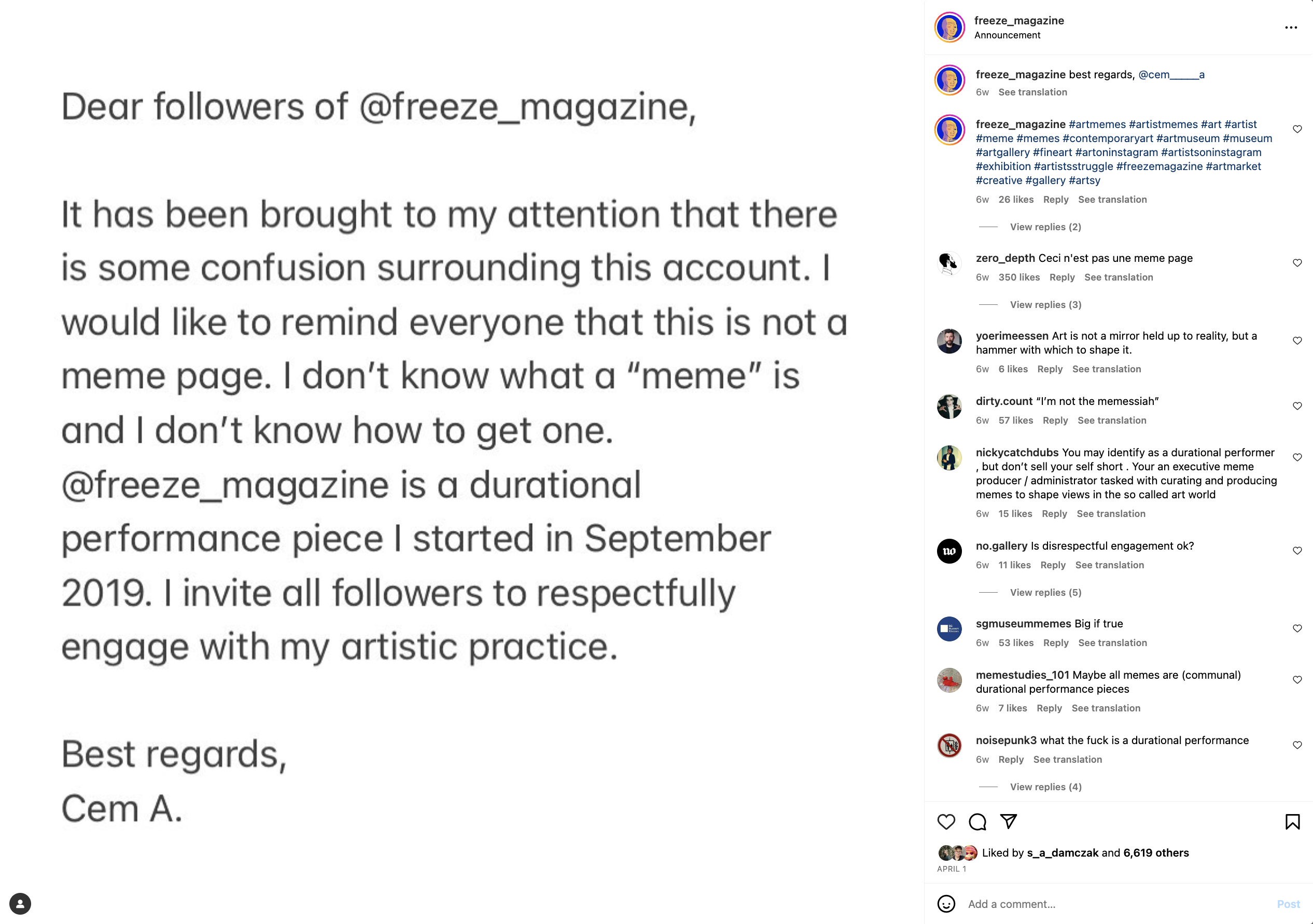
The attention paid to their internet presence is evidenced by the carefully managed and edited nature of their interviews and responses (including their response to my inquiry).17 As an example of an interview, that is trying to force an answer, read further: Levinson, Eliza. “Are Memes Praxis?” Arts of the Working Class, 18 Nov. 2022, https://artsoftheworkingclass.org/text/are-memes-praxis Paradoxically I don’t see this situation as something negative, rather I see it as a form of a twisted critique directed to the artworld structure subdued to the regimes of capitalist realism.
Kunst concisely grasps the paradoxes of my utopian assumptions of a situation where an artist who wants to do nothing (but is not privileged with guaranteed sources of sustenance such as inherited wealth), is forced to work in another profession or becomes co-opted by the mechanisms he’s trying to escape. What follows from this mechanism, is that neutrality is not a prevalent characteristic of withdrawals within the art world. Although I would argue against the statement that this condition strips the artist from being an artist. This precarious condition is widely normalized by the conditions and costs of living under the hegemony of capital. Nevertheless, the decision to label an artist’s non-work as art is never left to the decision of the artist herself. It is a broadly understood institution that takes over the function of signifying. This is why I’m still standing behind the ideas of Jerzy Ludwiński and the postartistic condition as the most open potentiality, where you may or may not signify a phenomenon as art or not-art (or both at once). The constitution of art/not-art/absent art is no longer dependent on the conditions of production if the overall condition is the postartistic age.
The New Masters of the Art World's Discontent
The examination of the concept of an art meme also led me to the question of the function of humor in art memes as part of the attention-capturing system. The layers of irony constituting the humorous tone hold the aforementioned mirror and therefore the potential of criticality, fulfilling yet another of Ludwiński’s requirements on the emphasis on the critical ideas towards reality. @freeze_magazine, like many other art meme accounts (eg. @artreviewpower100, @jerry_gogosian, @sad_berg_covid_memes @staedelschule_memes @internationalmountmakerforum, @memeclassworldwide, @art.goss, @white_pube, @curators_complaining, and many others) is led by an artworld’s disillusioned insider. It is reasonable to assume that the nature of the content produced by individuals experiencing disappointment or dissatisfaction will exhibit a tendency towards a critical perspective. Because of the art world’s hierarchical structure and elitist nature, meme’s self-critical and humorous content, acting as a counterweight to the art world’s inequality, appeals to a broad spectrum of art audiences – as there are more of us, who resonate with the disenchantment it channels. “Like reality television, art-world meme accounts offer their audiences – savvy enough to get the references but too marginal to be the object of scorn – a combination of flattery and catharsis.” – that’s what gives art memes such popularity and therefore potential to serve as art/cultural critique, as said by Mike Pepi in “Frieze Magazine”.
The sudden surge in art meme pages did not come from anywhere. As Melanie Bühler notices the current cultural climate is characterized by a heightened level of scrutiny directed towards institutions, particularly those within the realm of the art world. The use of social media provided a platform for individuals to voice their concerns about the various ways in which institutions operate, including in terms of structure, politics, and finances. They became the primary tool for launching critical campaigns and rallying calls against institutions of power. Hashtags have become a popular lexicon for these efforts, and the practice of openly criticizing institutions is no longer confined to progressive, activist, or artistic leftist circles. As a result, the issues of power structures, inequality and overall social awareness have become an increasingly prominent feature of public discourse and debate.
The extended field of art also calls for an extended notion of institutional critique. Artists are not lost in the understanding of cultural languages and definitely do not draw lines between pop-cultural irony and serious critique. It’s the art criticism and art theory that fails to employ the short-form and internet lingo as its means of communication. Internet culture has given rise to new forms of critique that draw attention to the medium they employ and the material they utilize, taking the form of a hashtag, a tweet or a meme. If we understand that as a new art recording/inscription, we are landed with Ludwiński’s fourth stage of art evolution towards the non-art/absent art. These forms are significant as they offer insights into the current ways critique is performed within the larger socioeconomic context.
These new forms of critique often employ the use of irony and humour, emotions, hashtags, short lines, and evocative images, all of which are important tactics that make them effective. The centrality of these new forms of critique in internet culture highlights the importance of understanding them in the academic discourse, where it was promptly accommodated by the ‘affective turn’. Thus, the meme maker’s labour takes the form of not only the image and text but also of using a certain tactic to compete in the attention economy. The notion of artists attempting to depart from the traditional art form or exit the art world for good through recourse to meme creation is fallacious. This assertion is reinforced by the evidence presented, which illustrates the demanding nature of meme-making as a form of not only artistic expression, but acknowledging the tactics and strategies within social media structures (it is hard work, but invisible work).
Meme page admins often handle all tasks, including dealing with unwanted comments. This can lead to burnout, forcing some to ignore interactions that conflict with their values. Memes are tools against injustice, yet their creation and usage for spreading awareness are a form of unpaid labour exploited by social media platforms. Despite social media being a key source of information, it's also a hub for misinformation. Memes are a form of bottom-up knowledge production, running counter to the oppressive public discourse, allowing marginalized groups to create alternative representations. They often act like infographics, leveraging the digestibility of pictorially represented information.
It was bibliometrically proved in 2019 that infographics are resulting in greater Altmetric Attention Score and social media attention in comparison with original research articles on similar topics.18Kunze, Kyle N., et al. “Infographics Are More Effective at Increasing Social Media Attention in Comparison with Original Research Articles: An Altmetrics-Based Analysis.” Arthroscopy: The Journal of Arthroscopic & Related Surgery, vol. 37, no. 8, 2021, pp. 2591–2597., https://doi.org/10.1016/j.arthro.2021.03.056. In the report, we can also read “We recommend the routine creation of infographics by journals to increase the social media attention that their research and chosen topics of interest receive.”19Ibidem. Based on the information presented, memes have the potential to effect real change. This is likely due to their ability to capture and hold the attention of audiences in an age where attention spans are increasingly shortened, and individuals are less inclined to engage with texts, which are too long to read. Furthermore, the brevity and concision of memes make them more accessible, as they require less cognitive effort to process and comprehend, but still stimulate critical thinking. They are providing opportunities for raising social awareness as they reach huge audiences and become viral. As an example, @freeze_magazine has accumulated 159 000 followers to this day, matching, or even exceeding the reach of many ‘legacy’ outlets. “Memes blur the lines between art making and art criticism, which makes them interesting for the art world. Memes are also meant to evolve with trends. They are defined by the circulation of the image rather than the content of the image. (For instance, a painting of a meme does not carry the same potency as a digital meme that travels and evolves through the internet.)”, as put into words by Cem A. in an interview for “The Art Newspaper”. I would add that those basic features of how memes operate are also a basis for Ludwiński’s absent-art/not-art as the elimination of the material object and incorporation of time sensitivity are yet another stages in the postartistic evolution.
It is not unexpected that disillusioned artists-idealists, who want to quit the art world yet still harbour the belief in a better future, would turn to meme creation as a means of expression. This phenomenon can be understood as a result of the convergence of their conflicting motivations. Humour plays an important role in comforting discontented individuals, as it allows for ironic distancing. Art memes are offering a sense of belonging through the use of specific humour, understandable only for art enthusiasts (eg. referencing certain names, institutions or definitions, mocking International Art English etc.). This also makes memes perfect for this specific community, which communicates almost always indirectly as irony by its nature is implicit and ephemeral.
Where Persistence of Memory Meets Persistence of Meme-ory
As the art communities share what is needed for understanding irony, thus art memes are gaining more popularity and are becoming better agents in grabbing our attention. @freeze_magazine relies mostly on the text-over-image format, where the direct message is the caption and visuals, whereas the indirect message is what decides the ironic span. These two aspects are crucial for a meme to be successful. In order to create an affective environment, which empowers and affirms through self-identification, meme makers need to employ clear intentions of a viewer’s gaze, resentments and inside jokes, that would not be understood by a random or naive visitor. Idil Galip in her analysis of internet ugly notes that “This “knowledgeable” interpreter will be able to elucidate not only what the ironist has said but also (1) what she has not, (2) what she actually means and (3) her attitude towards this intricate play of inclusion and exclusion. However, an equally important point to note is that irony not only depends on the intention of the ironist but also on the viewers’ projections.” The complex ways in which this niche humour operates bear the potentiality of the affective force to act on the actual offline body.
“Networked affect, however, also can be a mediating and mobilizing force that has the capacity to stir social action [...] and thus to constitute a potential channel for political agency. Such encounters, connections, and disconnections operate as human and nonhuman networks of influence and interrelation that affect the life of the individual (now too frequently reduced to the “user”) on the micro level of quotidian operations and tasks, as well as in the rhythms of communication, thought, entertainment, and information management.” as we can read in Networked Affect edited by Hillis, Paasonen and Petit.20Hillis, Ken, et al. Networked Affect. MIT Press, 2015, p.14-15. The one feature art memes cannot be denied is the use of humour as an affective practice – both emotionally and physically, it can cause us to laugh shakily, express delight through smiling, or even lead us to show discomfort or embarrassment by frowning and turning away. Art memes are evoking a sense of belonging in a community that is geographically dispersed but emotionally close, which is shown in the number of clicks. Technological and affective affordances of digital media can stimulate us in new, critical directions. Social media users are invited to participate in a wider community of art enthusiasts who employ humour as a means to critique and subvert unequal power structures and practices. As the change won’t happen overnight, memes might contribute to raising the awareness of art institutions over a longer period of time (It is a proven way to hold people and institutions accountable as shown by call-out and cancel culture and the use of hashtags and Twitter campaigns). Although liking, sharing and laughing allow us to relieve our emotions, it is never revealed if it reflects our opinion or not. Humour is the force behind a meme’s virality, while any original intention behind it (if there ever was one) quickly becomes irrelevant. The meme is shared and spread as a not-art(work) in the postartistic age, where the artwork’s structure is indeed disintegrating.
It’s Memes That Have The Power
A good example of the power of memes and their transformative capacity can be found in the stories of meme accounts administered by art school students or faculty. During the pandemic, the rise in the number of accounts coincided with the growing frustration with art academies’ handling of the new reality. @sad_berg_covid_memes is curated by an Amsterdam-based Sandberg Institute student, who decided to address her frustration through meme-making. I’ve observed the rising anxiety of the admin and the growing pressure from the Sandberg Institute board to delete the account or the calls for the person to reveal their identity. It was all posted on Instagram Stories (which I did not archive, as I didn’t know I’d ever need them) in which we could follow the harassment of the @sad_berg_covid_memes admin. Anonymity is one of the crucial advantages of meme-making. It allows you to name and voice your emotions and struggles, even if your professional or social position would not allow it. It also lends itself to the spread of misleading information and the stirring of unnecessary arguments. Anonymity puts enormous pressure on the admins, operating under the demand of credibility and its pressures. Nevertheless, a few meetings with the school board at Sandberg were organized to discuss the issues raised by @sad_berg_covid_memes and changes were implemented.21 Information posted in Instagram stories and confirmed in private conversations with Sandberg students.
Another example would be @memeclassworldwide run by faculty and shared with students of Muthesius University of Fine Arts and Design – a meme account where memes can be posted anonymously, serving as a research nexus, a space for criticality as well as an outlet for the frustration of its members. In July 2022 a meme mocking the faculty was posted, explicitly referencing the university’s specific professors and employees. Weeks later an official University’s Equal Opportunities Commission complaint was submitted to the University’s board asking for the posts to be taken down and publicly apologized for. @memeclassworldwide complied with both of the requests. After the incident the account became inactive. The incident demonstrates how the affective power of memes can be seen as threatening to offline bodies. These types of situations undermine the follower’s belief in the autonomy of a meme page and its readiness to stand its ground in the face of institutional pressures.
The Curious Plays of Anonymity and Exposure
Anonymity plays a double role; it can be an advantage but can also be used towards nefarious ends – both by those who post as well as those who mob them. In the highly competitive and scrutinized realm of the art world, where a single mistake can have significant consequences for an artist's career, some of the meme page admins have adopted a cautious approach, engaging in self-censorship and closely monitoring their content in order to avoid mistakes that could potentially impede future opportunities for a more traditional, established artistic career. This is particularly relevant in consideration of the potential for recognition and opportunities from established galleries and art industry figures, who may be inclined to offer a “more serious” artistic career if they like the meme page content. @freeze_magazine serves as a consistent source of humorous content, characterized by its use of inside jokes and clever commentary that critically examines institutional systems and power dynamics. He actively engages with various themes that are currently at the forefront of discussions within the art world. These themes include institutional critique and its role in shaping societal norms and values; the fair compensation of cultural workers and the labor they perform; gender equality within the art community and the broader creative industry; and the decolonization of art history, which aims to acknowledge and rectify the marginalization of marginalized cultures and perspectives within the field. Cem A. openly admits that he has also adopted a strategy of being cautious about the level of criticism directed towards well-established figures. With this tactic, the witty criticism becomes diluted.
Another factor in Cem A.’s persistent efforts at maintaining anonymity might be their prestigious and expensive education in London’s art college (and the insider knowledge that comes with it), which is why his objectives may extend beyond amassing social media following. Although I have to admit that this approach has proven to be effective, as evidenced by the positive results achieved by them.
Enlarge
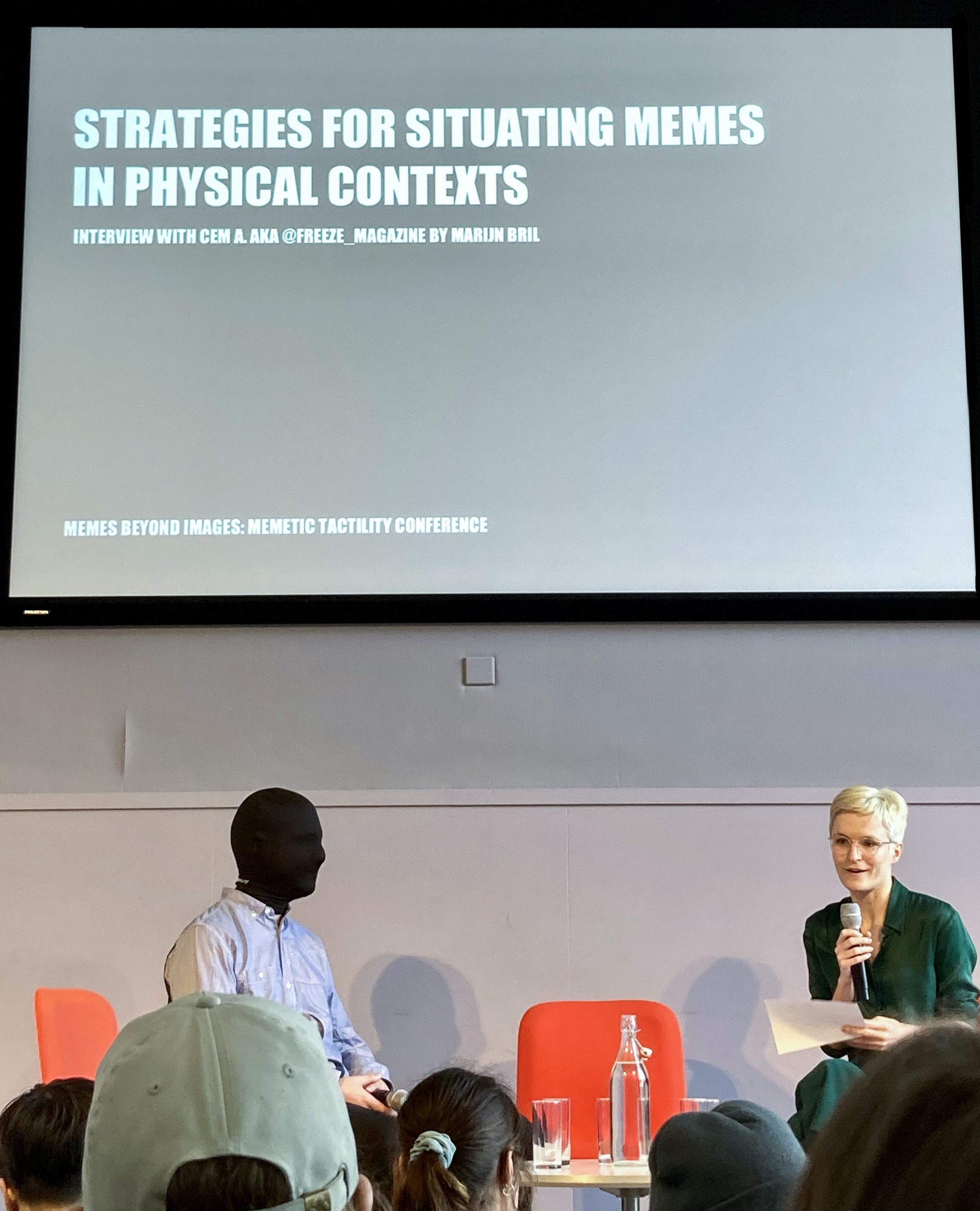
Institutional critique is no longer about commodification and prevailing the ideas of art’s autonomy and universality. I wouldn’t argue that memes are the new institutional critique but rather say that they can serve as critique per se, holding the potential for enacting real change in the art world.
Meme-Artwork-Meme-Artist-Meme-Viewer-Meme
It's compelling to consider the potential of what memes can become for art and their mechanisms that can be mobilized for hacking and expanding the field in the realization of Jerzy Ludwiński’s dream. Cem A. is calling his meme page a “tool for creative collaborations between Cem and fellow artists, researchers and organisations.” Again if they only knew that Ludwiński’s principle for the art evolution is an increased complexity of the triad artwork-artist-viewer they’d use that on their website too. Collectivity is an inherent feature of memes in general. Their virality and popularity depend on a collective effort. @freeze_magazine has significantly contributed to the meme studies and popularization of the format within the art world by collaborating with anonymous contributors as well as art institutions, although he cares about receiving credit (which isn’t a bad practice, but simply a losing battle as on the internet). Art memes' popularity coincides in time (2019/2020) with the popularity of topics of collectivity, community-building practices and commons.22For further reading: “Readers - e-Flux.” e-Flux Journal, June 2020, https://www.e-flux.com/readers/491177/collectivism and Tyzlik-Carver, Magdalena. “Interfacing the Common: Curatorial System as a Form of Production on the Edge.” public interfaces, (2011): n. pag. Print. These collaborative practices enabling creative forces are bearing the potential of restraining the idea of the artist’s ego and thus its possibility to go beyond the hegemony of the neoliberal ethos of the art world. For Ludwiński the lack of art’s uniqueness is also an important requirement. The aesthetics and features of memes can serve as an expression of Marxist principles – rejecting the art’s unique auratic and luxurious objects, produced to be consumed by the social elites. Memes diffuse both (re)production and consumption of themselves, eluding individual ownership by circulating through universal availability, making collectivity at once their condition and outcome. Memes serve as artworks reintegrating themselves into daily life through the use of social media.
Ludwiński and his theorization on the evolution of art towards not-art (absent art) of the postartistic age provide the framework through which to position memes as art merged with reality.23Ludwiński Jerzy, Ziółkowska Magdalena, Jan Chwalczyk, Charles Esche, Wanda Golkowska, Jarosław Kozłowski, Luiza Nader, and Paweł Polit. Notes from the Future of Art: Selected Writings of Jerzy ludwiński. Eindhoven: Van Abbemuseum, 2007, p. 26. The resonance between internet memes and Ludwinski’s thought becomes evident even through the cursory juxtaposition of the defining features of the former and art’s evolutionary stages proposed by the latter.24 Firstly it is a complete devaluation of artwork's status as an original and as a direct product of the artist’s craftsmanship; secondly an elimination of art’s material object (and degradation of its visual elements); third is a new and different mode of arts inscription; forth – augmentation of the work through an action in the temporal dimension. The fifth feature is an increased complexity of the relations involved in the artist-artwork-audience triad. The sixth is the radical disintegration of the artwork’s spatial as well as temporal structure. The seventh is the relocation of the artwork’s centre from the structural sphere (spatial and temporal) onto the conceptual one that offers a new picture of reality. The last one would be the artists’ attempt to leave the system traditionally considered as the art system. Own translation and summary from Ludwiński, Jerzy. Sztuka w Epoce Postartystycznej i Inne Teksty. Edited by Jarosław Kozłowski. Poznań, Wrocław: Akademia Sztuk Pięknych w Poznaniu, Biuro Wystaw Artystycznych we Wrocławiu, 2009, p. 62-66.
Given their structural characteristics and the strategic potential for exit from the art field they translate into, memes can be understood as stretched across the path of Ludwiński’s proposed evolution towards the not-art (absent art) fulfilling all of the eight parameters through which Ludwiński defines his dream.
I’m Sorry, I Don’t Know What Happened With Art But It Was a Lot of Work. Again.
Caught in a cycle of intense effort to grasp the concept of work refusal, here I am, caught in my own trap, once again, reflecting the paradox I was trying to untangle. My philosophical exercise to imagine a figure that wants to prevail in the status of an artist but refuses all work was proved to be impossible. Through the aforementioned stances of theorists and artists, I proved that it is possible to refuse the art work (artistic work), but not all work, as it sustains life itself. Even if we’re refusing all work it becomes harder to avoid the surplus value of labour as we’re in the age of data extractivism and we’re performing immaterial labour subdued to algorithms.
The digital origin of memes corresponds well with the possibilities of hacking the algorithmic regime of capital, not to mention memes' political potential. It is important not to underestimate the power of memes, as they possess the capability to elicit emotional affects through humour and virality and exert a potential for real social change. Memes have become a new tool for an effective critique of many complex systemic issues, as they are capable of quickly responding to real-life phenomena. My analysis of practices around memetic imagery opens up the avenues of thinking on memes as the fulfilment of Jerzy Ludwiński’s dream of a postartistic expanding field and the last stage of the evolution of art that is merged with reality. Memes are functioning across many different levels and exhibit a multifaceted nature, making it challenging to establish a definitive classification of them and to unequivocally identify them as art or not-art, thus this elusiveness might serve as an expanding field. Memes bear a lot of potential that is a crucial feature for Bojana Kunst, Anton Vidokle, Jerzy Ludwiński and others, therefore should not be definitively ruled out of serving as art works by the traditional art field. In order to more effectively demonstrate the condition of understanding memes as Ludwiński’s ideal, let’s consider one more time the example of the duck-rabbit illusion25The rabbit–duck illusion is an ambiguous image in which a rabbit or a duck can be seen. The earliest known version is an unattributed drawing from the 23 October 1892 issue of Fliegende Blätter, a German humour magazine. – a metaphor used often by the members of the Consortium of Postartistic Practices to navigate through the concept of expanding the field of what art/not-art (absent art) can be.
Essential literature:
Ludwiński Jerzy, Ziółkowska Magdalena, Jan Chwalczyk, Charles Esche, Wanda Golkowska, Jarosław Kozłowski, Luiza Nader, and Paweł Polit. Notes from the Future of Art: Selected Writings of Jerzy ludwiński. Eindhoven: Van Abbemuseum, 2007.
Ludwiński, Jerzy. Sztuka w Epoce Postartystycznej i Inne Teksty. Edited by Jarosław Kozłowski. Poznań, Wrocław: Akademia Sztuk Pięknych w Poznaniu, Biuro Wystaw Artystycznych we Wrocławiu, 2009.

